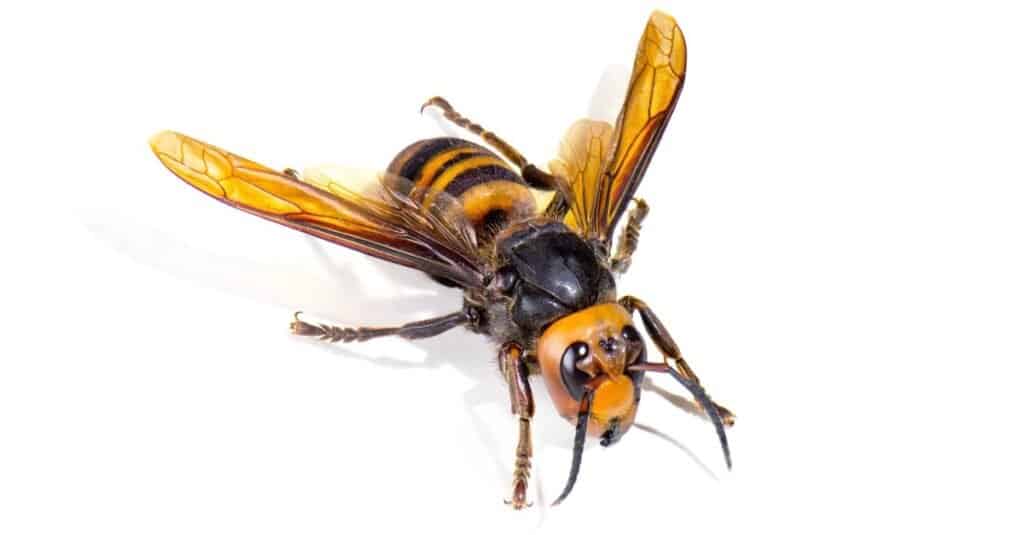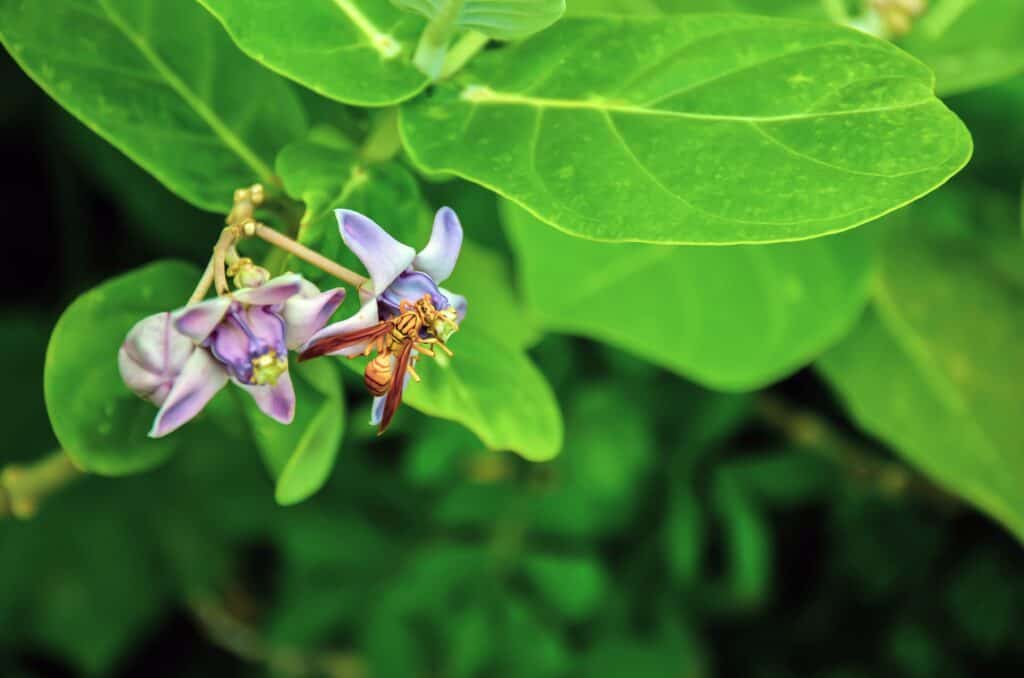People in the United States have recently become acquainted with a new, frightening nickname for a hornet. It’s called the “murder hornet”, and it is a non-native species that has crossed the Pacific Ocean, terrifying people who are worried about this massive wasp. Another large wasp with a scary name has emerged in the southern U.S. from Central and South America. So, what are the differences between the executioner wasp vs Asian giant hornet?
We’ll show you the five ways that they’re different and why you’ll want to avoid both of them.
Comparing Executioner Wasp vs. Asian Giant Hornet
| Executioner Wasp | Asian Giant Hornet | |
|---|---|---|
| Size | Up to 1 1/4-inch body length, and a wingspan of 3 inches | Measures 1 1/2 to 2 1/4 inches in body length with a wingspan of 3 inches |
| Species | – Polistes carnifex – Member of the paper wasp family | – Vespa mandarinia – Also called the “murder hornet” |
| Morphology and Coloration | – Yellow with brown stripes on the abdomen – Long, narrow wings with a brown tint – Long yellow antennae – Crown of the head may be black with reddish-brown stripes – Has wide cheek plates – Short, wide mandibles | – Triangular head – Large, dark antennae – Brown thorax – Orange head – Brown-tinted wings – Striped abdomen with black or dark brown and yellow-orange colors |
| Range | – Central and South America – Few make their way into North America, but specimens have been collected in the American Southwest – Argentina, Brazil, Mexico, Paraguay, and others | – Primarily found in Asia – Has entered the western United States and Canada – Commonly found in Japan – Also found in Russia, China, Laos, Thailand, India, Nepal, Vietnam, and others |
| Sting Potency and Impact on Humans | – Delivers a very painful sting, potentially the most painful of any wasp – Apparently, the wasp is not that aggressive – No records of deaths caused by these wasps are readily available | – Has a very large stinger that measures 1/4 inch long – Introduces a neurotoxin into a victim – Multiple stings from many hornets can cause deaths – The amount of venom combined with its potency is dangerous – May kill upwards of 50 people per year due to multiple stings or allergies |
The 5 Key Differences Between an Executioner Wasp vs Asian Giant Hornet

While most hornets are about an inch long, the Asian giant hornet, the world’s largest hornet, can grow to double that.
©iStock.com/kojihirano
The greatest differences between an executioner wasp and an Asian giant hornet can be found in their size and morphology. The Asian giant hornet is larger than the executioner wasp, having a body length between 1 ½ and 2 ¼ inches and a wingspan of 3 inches while the executioner wasp has a body length of 1 ¼ inch and a wingspan of 3 inches.
The executioner wasp has a primarily yellow body with brown stripes on the abdomen, long yellow antennae, and narrow wings with a brown color to them. While the Asian giant hornet also has brownish wings, they have an orange color on their head, a brown thorax, and an abdomen striped with black and yellow-orange colors.
These qualities represent the biggest differences between the two species. Yet, we can look at other traits to distinguish them. Let’s take a closer look at the executioner wasp and Asian giant hornet!
Executioner Wasp vs Asian Giant Hornet: Size
The Asian giant hornet is larger than the executioner wasp. On average, the Asian giant hornet measures between 1 ¼ inch and 2 ¼ inches in length, and it has a wingspan of 3 inches. The Asian giant hornet is the largest hornet in the world.
While the executioner wasp has the same wingspan length as the Asian giant hornet, its body only grows between 3/4 inch to 1 ¼ inch long.
Executioner Wasp vs Asian Giant Hornet: Species
The executioner wasp belongs to the species Polistes carnifex, and it is a member of the paper wasp family. However, the Asian giant hornet is a member of the Vespa mandarinia species, and they also go by the name “murder hornet” and northern giant hornet.
Executioner Wasp vs Asian Giant Hornet: Morphology and Coloration
The executioner wasp is yellow for the most part, but it has brown stripes along its abdomen. The wasp is known for having long yellow antennae and wide cheek plates. They have short, wide mandibles and the crown of their head can be black with reddish-brown stripes.
The Asian giant hornet has a brown thorax, an orange, triangular head, and a striped abdomen with black or dark brown and yellow-orange colors. This hornet also has long antennae, but they’re dark brown instead of yellow like the executioner wasp.
Executioner Wasp vs Asian Giant Hornet: Range
The ranges of the executioner wasp and the Asian giant hornet are very different. The executioner wasp is native to Central America and South America, but it has come into the southern extremes of North America such as Arizona and Texas in the U.S. The executioner wasp lives in Argentina, Brazil, Mexico, Paraguay, and the U.S.
However, the Asian giant hornet is native to Asia, but it has come to be a non-native species in parts of the U.S. and Canada. The hornet is most common in Japan, but it can also be found in Russia, China, India, Nepal, Laos, and some other countries. Currently, experts are doing everything they can to prevent this species from taking root in the U.S. and Canada.
Executioner Wasp vs Asian Giant Hornet: Sting Potency and Impact on Humans

The executioner wasp’s sting is one of the most painful in the world, yet they are responsible for less deaths than the Asian giant hornet.
©Lingkon Serao/Shutterstock.com
The executioner wasp is known for delivering one of the most painful stings of any wasp. Fortunately, this creature is not aggressive and lives in somewhat remote areas. Furthermore, there are no records of the wasp killing people.
Meanwhile, the Asian giant hornet is responsible for dozens of deaths annually. Their massive stinger injects large quantities of a moderately powerful neurotoxin. Outside of allergic reactions, the Asian giant hornet does not have enough venom to kill a person. However, if a person disturbs their nest, they can group up and kill a person with the sheer volume of their venom.
The Asian giant hornet is more dangerous than the executioner wasp, but the two are easy to tell apart. They’re both large insects, but their coloration, size, and morphology will tell you everything you need to know to identify them. Still, you should make sure to avoid them in the rare event that you see either creature.
Up Next:
- Wasp vs Bee: 7 Main Differences Explained
- Wasp vs Yellow Jacket: 5 Key Differences Explained
- Beehive Vs Wasp Nest
- Bee Sting Vs Wasp Sting
The photo featured at the top of this post is © iStock.com/kojihirano
Sources
- University of Maryland Extension, Available here: https://extension.umd.edu/resource/northern-giant-hornet
- Penn State Extension, Available here: https://extension.psu.edu/asian-giant-hornets
Thank you for reading! Have some feedback for us? Contact the AZ Animals editorial team.






